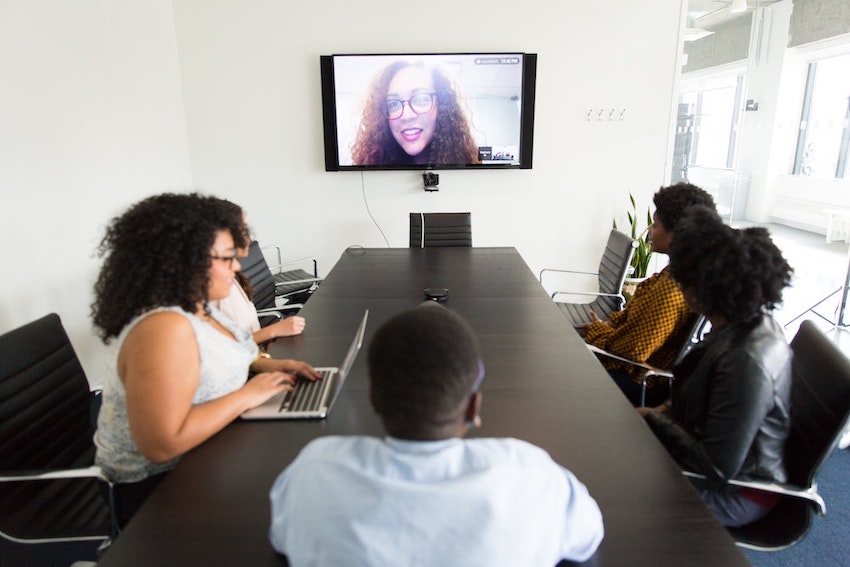There were a lot of important life lessons learned during lockdown. One of the most important: video conferencing platforms are a lifesaver. Much like masks and social distancing, video conferencing helps keep communities safe by allowing companies to operate and communicate remotely from home offices during a global health crisis.
As grateful as we all are for video conferencing, it’s safe to say that after all this time, many professionals are experiencing some of the side effects of video calling. Jokingly referred to as “Zoom fatigue”, the exhaustion, muscle pain and other side effects of video calling that many remote workers experience are no laughing matter. These issues are real and they have taken a toll on many professional and personal lives.
As the world continues to reopen and more businesses return to on-site, in-person work models, there are just as many businesses who remain remote or pursue a hybrid work model. Since companies will continue to rely on video conferencing, there are a few steps you can take to relieve “Zoom fatigue” and make your next video meeting more productive and enjoyable.
1. Send Materials in Advance
If the purpose of your scheduled video call is to review a document or presentation, then you should send those materials to all attendees well in advance of the meeting. This effective and efficient action allows participants to familiarize themselves with the information included in the materials so the host won’t have to spend most of the meeting reviewing every piece of data. Sending materials means more time is spent focusing on the more important matters which generates better discussions and leads to great productivity.
2. Make Time for Small Talk
If every virtual meeting begins by immediately getting down to business, then everyone involved is going to burn out quickly (especially if they have back-to-back-to-back meetings). Although the intent of getting down to the business at hand is to “not waste time”, it often makes attendees feel like they’re in “work overdrive”. To prevent everyone from experiencing video call burnout, allow some time at the start of the meeting for casual conversation. Whether it’s a few minutes for everyone to chat about their families, vacations, pets or even a TV show, these moments allow participants to connect with each other, relieve some of the stress they’re feeling, and set the table for a more productive meeting.
3. Keep the Cameras On
One of the biggest challenges during video conferencing is the increase in distractions. These distractions not only come in the form of children who need assistance with remote learning or pets who want to play, they’re also found in professionals who multitask during a call. And these distractions often intensify when the participants turn their cameras off. To prevent or curb these distractions, ask that all attendees turn their cameras on during the meeting. This practice ensures that everyone is more focused on the matters at hand – and less likely to be distracted by their environment or the urge to multitask.
4. Schedule “No Calls” Time
There aren’t enough hours in the day to perform daily duties – and attend multiple meetings. When the day’s schedule is filled with non-stop virtual meetings, it results in longer work days for remote professionals. In order to fulfill their daily assignments, they often sacrifice their free time to get the job done. That’s a sure fire way to become fatigued and burned out. To avoid that scenario, it’s best to schedule a block of time each day for assignments only. Set a “No Calls” time block of two-three hours each day to prevent being overwhelmed with video calls and virtual meetings.
5. Shared Meeting Space
As convenient as video conferencing is, it can also lead to feelings of isolation and frustration. Although it allows participants to communicate with each other at any time from anywhere, it does so without the interpersonal connection that helps companies thrive. Renting shared meeting space for regular in-person meetings provides the necessary attributes of leadership, teamwork, and collaboration that are often missing when companies rely solely on video conferencing.
Video conferencing is a necessary tool for modern business models – but it’s not the solution for every business scenario. Blending remote work and videoconferencing with coworking office and meeting spaces like those offered by HeadRoom, allows small businesses with remote staff the chance to both work independently when convenient and collaborate when necessary. HeadRoom’s shared meeting and office spaces prevent remote work burnout and the adverse side effects of video calls by providing businesses with access to a professional sanctuary whenever they need it. With three Philadelphia area coworking and meeting space locations in Media, Aston, and Wayne, HeadRoom is now accepting new memberships today. Contact us to learn more about our shared meeting and office space availability.

